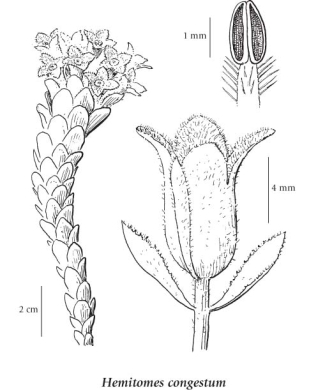Click on the image below to view an
expanded illustration for this species.

|
General:
Perennial herb from a fleshy, short rhizome; parasites on mycorrhizal fungi associated with trees; "stems" erect, simple, 3-15 cm tall, stout, waxy, glabrous; pinkish when fresh, drying to brownish; not persistent after seed dispersal; without chlorophyll.
Leaves:
Scale-like, to 2 cm long, partly overlapping like shingles, thin, oval to oblong, margins irregular and fringed with hairs.
Flowers:
Inflorescence a terminal, short, head-like, compressed spike; calyces and corollas similar in texture and colour; about equal in length, pinkish when fresh, drying to brownish; corollas tubular bell-shaped, 12-20 mm long, often unequally lobed, lobes 4 (5), densely hairy inside; sepals (2) 4, oblong, 12-18 mm long, lateral 2 often folded, clasping corolla; filaments densely hairy; anthers 1-2 mm long, unawned.
Fruits:
Berry-like capsules, egg-shaped, to 1 cm long, hairy.
Notes:
Stem and leaves can be considered part of the inflorescence.
Source: The Illustrated Flora of British Columbia
|
